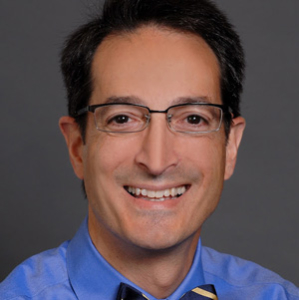
Damian Zikakis, director of career services at Michigan Ross School of Business. Photo courtesy of Michigan Ross
DITCH THE PRESENTATION AND BRING THE PIZZA
According to Zikakis, accounting firms and investment banks are competing the most for Ross’s top students, which is leading to some of the unusual tactics. “It’s hard for the big four accounting firms to differentiate themselves when they’re all in the same room,” he claims. “And they all have large hiring needs.”
To be sure, one of the big four seems to be putting in some interesting efforts to garner attention. Last year, PwC took to food. The accounting firm parked a PwC branded coffee truck on the footsteps of Ross’s campus and handed out free coffee, tea, and hot chocolate. “Students could walk up and get a cup of coffee—whether they were interested in accounting of not,” Zikakis recalls. “It created a buzz.”
On Kelley’s campus, PwC replaced the coffee truck with an ice cream truck. “Food seems to be attracting students right now,” Clarke says of the stunt. “We tell companies to come in and bring pizza, bring a bunch of people, and sit down and talk. They’ll get way more out of that than trying to do a Powerpoint presentation. The students don’t need that. Food’s critical.”
Tomas also sees companies “wooing” Carlson students with dinners and food. “One thing students never get tired of is food,” she concludes. “But I also see food companies needing to show they care about nutrition and how products get sourced and how they share that story with students.”
‘PERSONALIZING’ THE RECRUITERS KEY
The career services directors are also seeing a generation of students seeking more connection with their potential employers and the missions of those companies. Tomas says for the past couple of years her office has recommended that companies creatively communicate their impact and mission. “Today’s students want to be connected with the mission. On a larger scale, students want to be connected to what the company does,” she points out.
Zikakis recalls that “one of the big consulting firms” printed baseball cards with unique information about their recruiters. Although Zikakis and his office couldn’t remember which company it was he says it changed the perception of the company’s representative, which at times can come off as impersonal or distant. “They are no longer recruiters, but someone a student can relate to,” he says.
PepsiCo did something similar, creating an info-sheet that had fun-facts about each of their 15 recruiters to visit Ross. Zikakis says the info included everything from their favorite PepsiCo product to their favorite Michigan memory. “They personalized the recruiter—as opposed to the student walking into a big corporate presentation and seeing 15 people at the front of the room and not knowing anything about them or what to talk about,” he explains. “This kind of seeds that conversation.”
Sometimes, though, even the personalized cards and fun-facts aren’t enough. Zikakis says his office will recommend companies “do an invitation-only event earlier in the day or the next day.” He says personal invites and opportunities to chat with executives are also attractive to top talent. “We’ll see companies do what they call a fireside chat—it’s funny how these names get used over and over again, we don’t have a fireplace—but it winds up being a small group with an executive,” Zikakis laughs. “There aren’t many companies that do it, but those that do, find them useful.”
Tomas says Minnesota-based Land O’ Lakes has seen success in recruiting Carlson students by bringing in CEO Christopher Policinski. “It helps students see they will have access to the leader and helps them connect with the company and mission,” she adds.
‘THEY DON’T WANT THAT SWAG’
But of course, some recruiting efforts happen in vain. And increasingly, those efforts revolve around SWAG. Zikakis says bringing SWAG—once an effective recruiting tactic—no longer excites students. “When I first got here there was lots of SWAG,” Zikakis claims. “There were a lot of plastic water bottles—like Nalgene bottles—and I actually started collecting them and display a dozen of them on my windowsill in my office. There were key chains, pens, thumb drives, and backpacks—all sorts of SWAG with company names on it. And this year, there’s almost no SWAG at all.”
It might be because students seem to increasingly despise SWAG. Zikakis says students are now viewing SWAG as a waste and it often ends up in a landfill. Tomas and her office take a thanks, but no thanks approach. “We’ve actually asked them (companies) to stop bringing it,” Tomas says of SWAG items. “Students don’t want that. To them it feels like waste. These are students interested in their global footprint. They don’t want plastic things everywhere. They don’t want that SWAG.”
Clarke says she’s seen it all over the years from waterproof shower speakers to Camelbak water bottles to Kleenex tissues. “I know some schools have done that,” she says about asking companies to keep their campuses a SWAG-free zone. “But we’re just saying it’s not necessary.”
Both Clarke and Zikakis noted that SWAG can sometimes cause awkward moments. “Our students at a career fair don’t want to be carrying around a company’s SWAG when they go to booths of other companies,” Clarke says. Zikakis also mentioned students needing to throw away SWAG when they’ve been hired by that company’s competitor.











Questions about this article? Email us or leave a comment below.